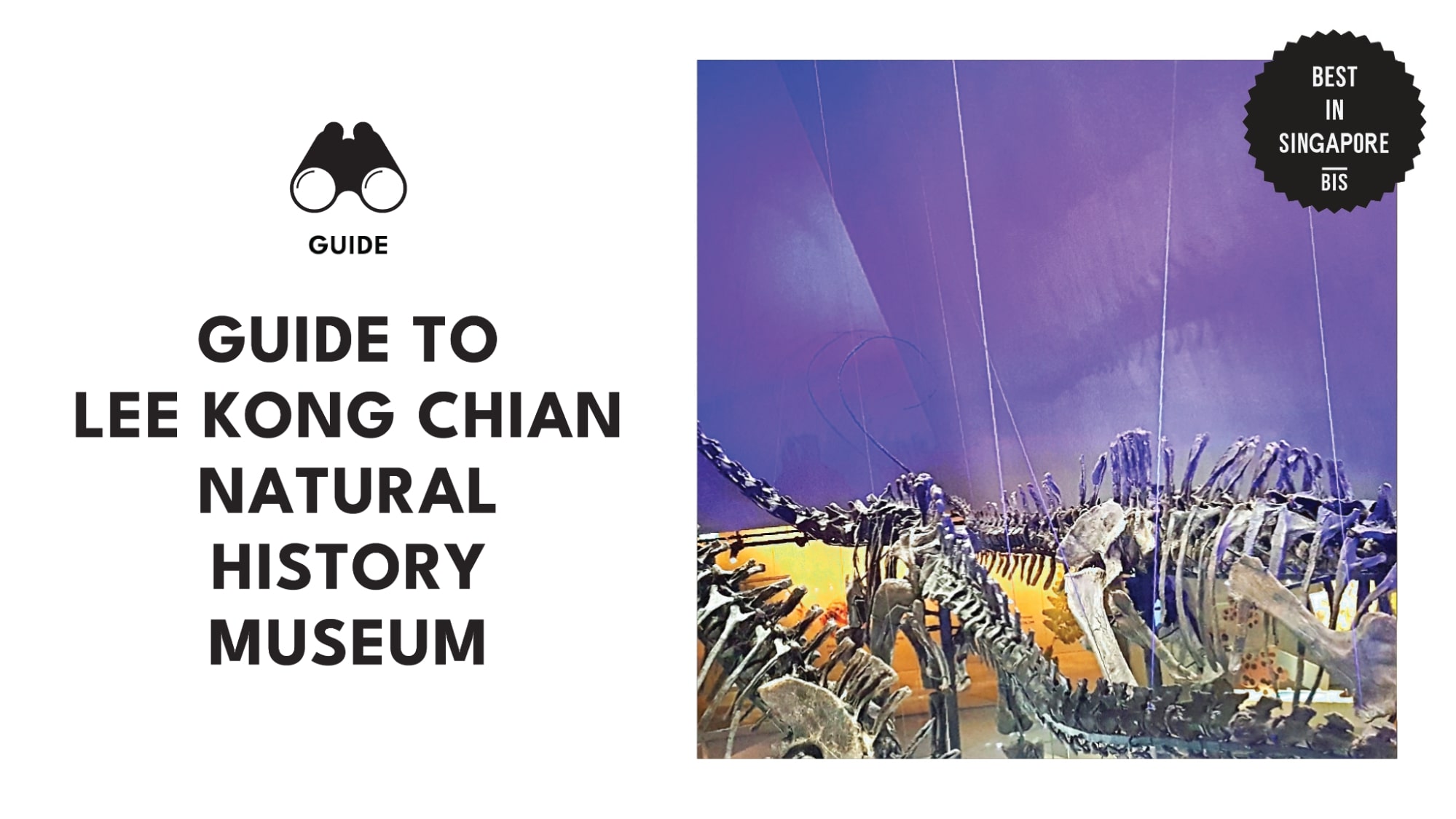A Palaeontology Enthusiast’s Guide to Lee Kong Chian Natural History Museum
When I was a child, I watched and was obsessed with the Jurassic Park films—the original ones, with Sam Neill, Laura Dern, and Jeff Goldblum. I started daydreaming of becoming a palaeontologist and discovering dinosaur fossils.
Unfortunately, that dream didn’t come true, but the interest in dinosaurs still stands. It’s a good thing that Singapore has the Lee Kong Chian Natural History Museum (LKCNHM); the galleries of fossils here are enough to satisfy my curiosity.
If you love natural history as much as I do, you’ll also love this museum, which is housed inside the country’s premier university. Here’s a guide to help prepare you for your journey.
Things to Know
Address: 2 Conservatory Dr, National University of Singapore
Operating Hours: Tuesday to Sunday—10 am to 6 pm
Contact Number: +6566013333
Website
How to Get Here
By MRT and Bus: Ride the train to the Clementi MRT Station. Then, transfer to Bus 96, which will take you to the museum.
By Bus: Ride Bus 96 and 151 from SBS Transit and Tower Transit, respectively, then alight at the museum (Bus Stop No. B16161).
By Car: There’s parking available at the museum (NUS Car Park 3A) and Yong Siew Toh Conservatory of Music (NUS Car Park 3). The parking rate is S$0.0214 per minute upon exit.
On Sundays and public holidays, you can take advantage of their free parking promo.
Admission Fee
If you’re a student or staff member of the National University of Singapore, you can enjoy free entry to the museum (did you know there are plenty of free museums here?). Just make sure to bring your ID.
You can buy your ticket at the ticketing counter or online via SISTIC. If you’re planning to come here with a large group (13 people or more), email [email protected] for more information.
Promos
One thing I like about this museum is that they offer a special promotion for your birthday. If you visit during your birthday month, you’ll be able to enter the museum for free! And that’s not all—you’ll also receive a special edition museum enamel pin.
Just bring an official ID or document that shows your birthday.
Visit Sessions
To control the crowd inside the museum, the staff implements visit sessions. There are three visit sessions every day: Session 1 is at 10 am, Session 2 at 1 pm, and Session 3 at 4 pm.
These times are only for entering; if you miss the opening for Session 1, you’ll have to wait for the next one. Once you enter the gallery, there’s no time limit, so feel free to explore the museum as much as you want.
Museum Etiquette
Please follow the museum etiquette to ensure you and all the other visitors have a comfortable experience. Here are the most important rules to follow.
- Food and drinks are not allowed inside the museum. This is to avoid attracting mould and pests, which would destroy the artefacts inside.
- Don’t just throw your trash anywhere. If you don’t see a trash bin, hold it until you do.
- Flash photography isn’t allowed. The light might damage some of the more fragile items, making their colours fade.
- Don’t use selfie sticks. They might cause accidents with the artefacts.
- Don’t touch the glass of the displays. Also, don’t touch the artefacts themselves. Your body oil and perspiration might damage them.
- Don’t lean or climb onto the display cases. Doing so might cause them to crack.
- Please keep your voice low if you want to talk. You don’t want to disturb the other visitors.
- Don’t run inside the museum.
Galleries to Check Out
Heritage Gallery
From: lkcnhm
I have to say that the Heritage Gallery is the heart of the LKCNHM. This gallery shows the natural history of Singapore and the Southeast Asia region as a whole, and wow, it’s fascinating!
The items inside this gallery used to be housed at the Raffles Library and Museum (now the National Museum of Singapore) from the late 1800s and early 1900s. Browsing this gallery makes me feel like I’ve travelled back in time.
My favourite item here is the leatherback turtle, which also happens to be the museum’s prized possession. It was found dead near Siglap Beach in 1883, and to this day, it’s still the only known record of such an animal in Singapore! Its mysterious nature truly intrigues me.
Biodiversity Gallery
From: lkcnhm
The Biodiversity Gallery has to be my favourite because of its various animal fossils! Essentially, the point of this gallery is to showcase the beginning of life on Earth and how it’s evolved over time.
Currently, there are 15 zones here—from plants and amphibians to extinct reptiles and mammals. Here are some of my favourites in this gallery.
Dinosaur Fossils
From: lkcnhm
Well, of course, the dinosaur fossils are some of the highlights for me. The girl obsessed with Jurassic Park when she was a child, remember?
The fossils in this gallery are of the diplodocid sauropod dinosaurs, which were believed to be some of the largest and heaviest animals to walk on land.
Two of the dinosaur fossils have skulls, which is impressive considering that skull fossils are hard to find for sauropods!
Standing next to these sauropods, I always feel like an ant. Imagine how much bigger they were!
Singapore Sperm Whale
From: lkcnhm
Another one of my favourite items in this gallery is the Singapore Sperm Whale. This whale was found dead off Jurong Island back in 2015, and it’s the first record of a sperm whale in the country. That fact alone is why I love it.
I’ve never seen a sperm whale, so you can imagine the awe on my face whenever I see this display. The skeleton is almost 11 meters long, a fact that I struggle to wrap my head around.
Slice of Changi Tree
From: lkcnhm
I know I mostly gush about animals in this article, but I do like plants too, especially local ones! So, I have to give a shoutout to the display of chengal pasir—best known as “slice of Changi tree.”
Chengal pasir is a rare dipterocarp tree; in fact, it’s so rare that experts think it’s locally extinct. A chengal pasir was found in 2002, the only one of its species in Singapore, but it was illegally cut down the same year. Since then, the museum has kept a slice of it in remembrance.
Seeing this lone slice makes me sad. Just think of all the extinct trees we’ve lost through reckless logging.
Zoological Reference Collection
From: lkcnhm
The LKCNHM is more than just a museum with fossils and other artefacts on display for the public; it’s also a research institution that actually plays a leading role in Southeast Asian zoological research!
That’s why this museum houses the Zoological Reference Collection, which has over 100,000 specimens from different animal species across the entire Southeast Asia region.
Since this collection is for research purposes, the public can’t access it. But sometimes, the museum does display a few of the specimens. The last time I came here, I saw the preserved dried skins of mammals and birds and hard corals and molluscs in jars.
Pro tip: Organise a gallery tour!
From: littleskoolhousesg
If you’re travelling with a group—be it with friends, your students, or co-workers—then I recommend organising a gallery tour!
The museum offers a comprehensive tour of the Heritage and Biodiversity Galleries, and the tour guide will share interesting trivia and insights into the different displays.
The tour can also include specific learning objectives if you want. This addition is perfect if you’re coming with a group of young people.
If you’re interested, fill out this form.
Publications
From: lkcnhm
If you’re an absolute nerd who wants to know more about zoology and natural history, then you’ll be delighted to know that this museum has several publications—and you can access them, sometimes even for free!
My favourite is the Raffles Bulletin of Zoology, which is a peer-reviewed journal with papers about the taxonomy, ecology, and conservation biology of animals from Southeast Asia. The papers here can be pretty dense, but they’re exciting to read.
Another journal they publish is Nature in Singapore, and this one is totally free, which is why I love it. It’s also peer-reviewed, and the topics the papers cover are about the flora and fauna of Singapore.
Occasionally, there are books published by the museum—from coffee-table books about biodiversity to niche research topics. You can find these books at the museum shop.
Museum Shop
From: lkcnhm
Planning to bring home a memento of your visit to the LKCNHM? Then, be sure to drop by the museum shop.
As I mentioned in the previous section, this shop carries the museum’s published books, and those are my favourite things to check out.
But there are other items available here for purchase. I usually get the cute themed stickers and notebooks, and I’m eyeing to get a stuffed toy and a T-shirt the next time I visit.


